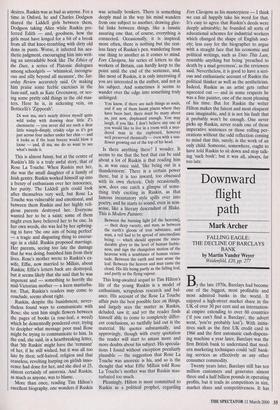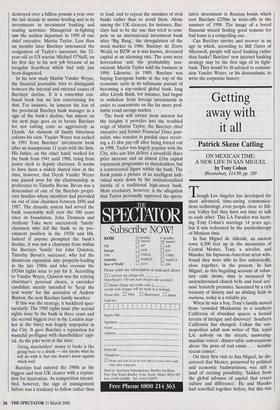Downward flight path
Mark Archer
FALLING EAGLE: THE DECLINE OF BARCLAYS BANK by Martin Vander Weyer Weidenfeld, £20, pp. 277 By the late 1970s, Barclays had become one of the biggest, most profitable and most admired banks in the world. It enjoyed a high-street market share in the UK of over 30 per cent and an internation- al empire extending to over 80 countries Cif you can't find a Barclays', the advert went, 'you're probably lost'). With initia- tives such as the first UK credit card in 1966 and the first automatic cash-dispens- ing machine a year later, Barclays was the first British bank to understand that mod- ern marketing techniques could 'sell' bank- ing services as effectively as any other consumer commodity.
Twenty years later, Barclays still has ten million customers and generates almost three and a half billion pounds in operating profits, but it trails its competitors in size, market share and competitiveness. It has destroyed over a billion pounds a year over the last decade in unwise lending and in its investments in investment banking and trading activities. Managerial in-fighting saw the sudden departure in 1998 of one chief executive, Martin Taylor. Less than six months later Barclays announced the resignation of Taylor's successor, the 52- year-old ex-US marine Michael O'Neill, on his first day in his new job because of an irregular heartbeat which had only just been diagnosed.
In his new study Martin Vander Weyer, the financial journalist, tries to distinguish between the internal and external causes of Barclays' decline. It is a somewhat con- fused book but no less entertaining for that. For instance, he laments the loss of the provincial Barclays bank manager as a sign of the bank's decline, but almost on the next page goes on to berate Barclays for not cutting costs as aggressively as Lloyds. An element of family bitterness colours his view. Vander Weyer was sacked in 1991 from Barclays' investment bank after an inauspicious 11 years with the firm. His father, on the other hand, worked for the bank from 1941 until 1988, rising from junior clerk to deputy chairman. It seems to have been a widely shared view at the time, however, that Deryk Vander Weyer was passed over for the chairmanship in preference to Timothy Bevan. Bevan was a descendant of one of the Barclays propri- etor families whose members had provided six out of nine chairmen between 1896 and 1987. The dynastic system had served the bank reasonably well over the 300 years since its foundation. John Thomson and Anthony Tuke were successively 'family' chairmen who led the bank to its pre- eminent position in the 1950s and 60s. Indeed if anyone prompted the bank's decline, it was not a chairman from within the Barclays 'family' but John Quinton, Timothy Bevan's successor, who led the disastrous expansion into property-lending in the late 1980s and who oversaw the £924m rights issue to pay for it. According to Vander Weyer, Quinton was the retiring chairman's personal choice, a caretaker candidate merely intended to 'keep the seat warm' for the accession of Andrew Buxton, the next Barclays family member.
If this was the strategy, it backfired spec- tacularly. The 1988 rights issue (the second rights issue by the bank in three years and the second biggest ever in the London mar- ket at the time) was hugely unpopular in the City. It gave Barclays a reputation for wasteful profligacy with shareholders' capi- tal. As the joke went at the time:
Giving shareholders' money to banks is like giving beer to a drunk — one knows what he will do with it, but one doesn't know against which wall.
Barclays had entered the 1980s as the biggest and best UK clearer with a reputa- tion for innovation. As competition intensi- fied, however, the sign of management failure was a tendency to follow rather than to lead, and to repeat the mistakes of rival banks rather than to avoid them. Alcine among the UK clearers, for instance, Bar- clays had to be the one that tried to com- pete as an international investment bank after 'Big Bang', the deregulation of the stock market in 1986. Barclays de Zoete Wedd, or BZW as it was known, devoured capital at an alarming rate. The costs were horrendous and the profitability non- existent. Martin Taylor sold the business in 1998. Likewise, in 1989, Barclays was buying European banks at the top of the economic cycle in its talismanic pursuit of becoming a top-ranked global bank, long after Lloyds Bank, for instance, had begun to withdraw from foreign investments in order to concentrate on the far more prof- itable retail savings market.
The book will attract most interest for the insights it provides into the troubled reign of Martin Taylor, the Barclays chief executive and former Financial Times jour- nalist, who remains in purdah since receiv- ing a £1.6bn pay-off after being forced out in 1998. Taylor was hugely popular with the City, who saw him deliver a sevenfold share price increase and an almost £1bn capital repayment programme to shareholders, but a controversial figure within the bank. The book paints a picture of an intelligent indi- vidual worn down by the institutionalised inertia of a traditional high-street bank. Most revelatory, however, is the allegation that Taylor personally approved the specu- lative investment in Russian bonds which cost Barclays £250m in write-offs in the summer of 1998. The image of a bored financial wizard finding good reasons for bad loans is a compelling one.
Can Barclays survive and recover in an age in which, according to Bill Gates of Microsoft, people will need banking rather than banks? Barclays' new internet banking strategy may be the first sign of its fight- back. They would be ill-advised to commis- sion Vander Weyer, or his descendants, to write the corporate history.



































































 Previous page
Previous page